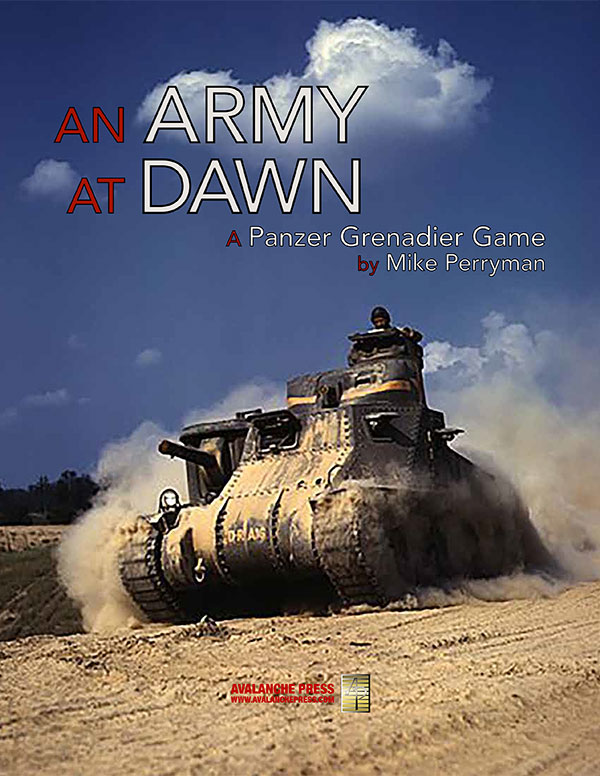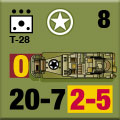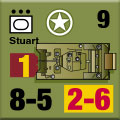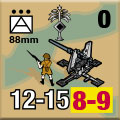| An Army at Dawn
Scenario Preview, Part Two
By Mike Bennighof, Ph.D.
June 2024
 The tightened focus of the new Playbook edition of Panzer Grenadier: An Army at Dawn makes it clear just how poorly prepared was the U.S. Army when it finally went to war in late 1942. That’s obvious just in the game information: initiative (which, in game terms, allows one side or the other to do more things and reflects logistics, staff planning and operational clarity as much as the vague concept of “initiative”) is usually not on the American side. Morale is not so good; again, this reflects things like unit cohesion as much as it does fighting spirit. The tightened focus of the new Playbook edition of Panzer Grenadier: An Army at Dawn makes it clear just how poorly prepared was the U.S. Army when it finally went to war in late 1942. That’s obvious just in the game information: initiative (which, in game terms, allows one side or the other to do more things and reflects logistics, staff planning and operational clarity as much as the vague concept of “initiative”) is usually not on the American side. Morale is not so good; again, this reflects things like unit cohesion as much as it does fighting spirit.
But most of all, you see it in the scenario parameters. American units are often fighting at a disadvantage (in numbers, position, mission or some combination) because, at a higher level than that shown in Panzer Grenadier, someone had blundered. And that someone was usually II Corps commander Lloyd Fredendall.
Let’s have a look at the scenarios from Chapter Three, which introduces the Americans to combat against the real Axis (not just the French).
Chapter Three
Hard Knocks
 The inexperienced U.S. Army faced a veteran opponent armed with modern weapons; even the scratch German units flung together from rear-area personnel and new recruits usually had a cadre of combat veterans. American tank destroyers employed a flawed doctrine and substandard equipment. The best American-made tanks had been shipped to the British, and the less-capable M3 medium tanks operated under outdated and unrealistic doctrine; that resulted in a brutal slap down of the Anglo-American Blade Force in the Tine Valley. The artillery branch had solid doctrine, plentiful ammunition, and outstanding weapons, while the infantry had been well trained even if their officers sometimes allowed slack behavior in combat zones (the failure to dig proper foxholes was a repeated complaint in after-action reports). The inexperienced U.S. Army faced a veteran opponent armed with modern weapons; even the scratch German units flung together from rear-area personnel and new recruits usually had a cadre of combat veterans. American tank destroyers employed a flawed doctrine and substandard equipment. The best American-made tanks had been shipped to the British, and the less-capable M3 medium tanks operated under outdated and unrealistic doctrine; that resulted in a brutal slap down of the Anglo-American Blade Force in the Tine Valley. The artillery branch had solid doctrine, plentiful ammunition, and outstanding weapons, while the infantry had been well trained even if their officers sometimes allowed slack behavior in combat zones (the failure to dig proper foxholes was a repeated complaint in after-action reports).
Scenario Five
Chewy-Gooey
26 November 1942
 The British First Army created an Anglo-American tank-heavy regimental group known as Blade Force to move into the Tine Valley and generate a “tank infested area.” Blade Force boasted over 100 tanks, no infantry, and all the easily-foreseeable problems of an ad hoc multi-national command structure. In response to an American raid on a nearby airfield the Germans sent in their own tanks to infest the valley. The British First Army created an Anglo-American tank-heavy regimental group known as Blade Force to move into the Tine Valley and generate a “tank infested area.” Blade Force boasted over 100 tanks, no infantry, and all the easily-foreseeable problems of an ad hoc multi-national command structure. In response to an American raid on a nearby airfield the Germans sent in their own tanks to infest the valley.
Conclusion
The relatively well-equipped 190th Tank Battalion, sent to North Africa to become the armored component of the Africa Corps’ 90th Light Division, had instead been diverted to the Tunisian front. Despite the well-documented use of long-barreled Panzer IVs against the British since May, word apparently did not trickle down to American tank battalion commanders. The Stuarts posed a poor matchup as Company A lost half of their twelve tanks in the first ten minutes. However, their sacrifice allowed Company B to take the panzers in the rear and eliminate seven of them. The Germans retired with the Americans in hot pursuit, but the fighting for Chouigui (known to the Americans as “Chewy-Gooey”) was far from over.
Notes
An American force with lots of Stuart light tanks and not much else provides target practice to a German combined-arms team including some Panzer IV tanks that will blow apart any Stuarts that come within range. The American player will have to dodge those and fight the weaker German units which, unfortunately, aren’t all that weak. This is likely to become a wreck-infested area.
Scenario Six
Tenth Panzer Division Advances
1 December 1942
 With 135 Allied tanks already east of the town of Beja the German LXXXX Corps headquarters, then controlling Axis forces landing in Tunisia, had few options to stop them. Over 1,000 men arrived in Tunisia every day, and they could not be deployed without at least some operational depth. Tenth Panzer Division had begin arriving on 27 November, a process that would take six days. Gen. Walther Nehring’s staff ordered what elements had disembarked to head toward Chouiqiu and stop the Allied advance. With 135 Allied tanks already east of the town of Beja the German LXXXX Corps headquarters, then controlling Axis forces landing in Tunisia, had few options to stop them. Over 1,000 men arrived in Tunisia every day, and they could not be deployed without at least some operational depth. Tenth Panzer Division had begin arriving on 27 November, a process that would take six days. Gen. Walther Nehring’s staff ordered what elements had disembarked to head toward Chouiqiu and stop the Allied advance.
Conclusion
Blade Force’s lack of infantry made defending Chouigui almost impossible. The Allied armor offered what resistance they could and then fell back to join 11th Brigade Group in their defense of Tebourba. The disorderly American retreat exposed the long columns of road-bound support vehicles to deadly attacks by German and Italian artillery and aircraft.
Notes
Tank fight! The Germans at least bring a little infantry with them; the Americans and British, nearly none at all. The bulk of the Allied tank force is made up of American Stuarts - weak armor, weak gun, weak morale. But you go to war with the army you have, and the American player will have to figure out how to gang up on the much tougher (but outnumbered) individual German tanks.
Scenario Seven
Tigers in Tunisia
1 December 1942
 Lt. Gen. Wolfgang Fischer, commander of the 10th Panzer Division, planned for two German battle groups operating on the north flank of the advance to take Tebourba after securing Chouigui and preventing Allied reinforcements from that direction. When those forces became bogged down, the General became impatient and ordered his exploitation force into action as well. Lt. Gen. Wolfgang Fischer, commander of the 10th Panzer Division, planned for two German battle groups operating on the north flank of the advance to take Tebourba after securing Chouigui and preventing Allied reinforcements from that direction. When those forces became bogged down, the General became impatient and ordered his exploitation force into action as well.
Conclusion
In confused fighting, the Royal Hampshires withstood the best the Germans could throw at them, including the vaunted Tiger tanks making their first appearance in Africa. The Tigers should have made the difference but seem to have contented themselves with tormenting the displaced Stuarts. Whether losing their commander to a sniper early in the fighting caused them to lose focus is unknown, but Fischer raged to his superiors about the low quality of the infantry attached to his tanks – hastily-assembled “Tunis Field Battalions” – late into the night.
Notes
Tiger tanks in the desert! Against American M3 medium tanks, it just doesn’t seem quite fair. It’s going to be hard to knock out the Tigers, but the rewards for doing so are substantial so the German player will have to be cautious with them.
Scenario Eight
Futility on Route 50
2 December 1942
 On the previous day the Germans had dominated the fighting and, except for the disputed Route 50, boxed in the British troops defending Tebourba. To open Route 50, Colonel Paul Robinett of the 1st Armored Division’s 13th Armored Regiment intended to take command of all Allied tanks in the area and launch a counterattack. He arrived on a ridge four miles west of Tebourba and started to set up his command post. On the previous day the Germans had dominated the fighting and, except for the disputed Route 50, boxed in the British troops defending Tebourba. To open Route 50, Colonel Paul Robinett of the 1st Armored Division’s 13th Armored Regiment intended to take command of all Allied tanks in the area and launch a counterattack. He arrived on a ridge four miles west of Tebourba and started to set up his command post.
Conclusion
“Always do whatever you can,” Robinett liked to say, “to keep your superior from making a mistake.” He probably should have had his eye on his subordinates instead; just as he arrived but before he took command, Blade Force’s Stuarts attacked a concentration of Panzer IV tanks, rumbling forward without any support. The Stuarts destroyed four panzers at great cost to themselves while eight Lee medium tanks burned for no appreciable gain. The remainder of Combat Command B assumed a defensive posture.
Notes
Just a small scenario, with a small but balanced German defending force taking on waves of unaccompanied attacking American armor. Weaker armor, weaker guns, weaker morale – what could go wrong? The Americans do have numbers on their side. Robinett’s version blames his underlings, but his division commander would fire him in May 1943 and he never commanded a unit in combat again.
You can order An Army at Dawn right here.
Big Red Package
An Army at Dawn
Big Red One
Retail Price: $92.98
Package Price: $85
Gold Club Price: $68
You can order the Big Red Package right here.
Sign up for our newsletter right here. Your info will never be sold or transferred; we'll just use it to update you on new games and new offers.
Mike Bennighof is president of Avalanche Press and holds a doctorate in history from Emory University. A Fulbright Scholar and NASA Journalist in Space finalist, he has published a great many books, games and articles on historical subjects; people are saying that some of them are actually good.
He lives in Birmingham, Alabama with his wife, three children, and new puppy. He misses his lizard-hunting Iron Dog, Leopold.
Want to keep Daily Content free of third-party ads? You can send us some love (and cash) through this link right here.
|
